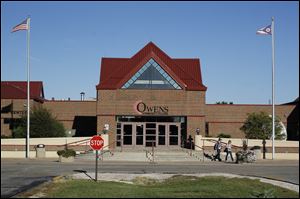
EDITORIAL
Financial Aid 101
State lawmakers must give community college students the help they — and Ohio’s economy — need
4/15/2014
Changes to the financial aid system made nearly all of Ohio’s community college students, including nearly 15,000 at Owens Community College, ineligible for state grants.
Most good-paying jobs in the coming decade will require more than a high school diploma, but less than a four-year degree. Ohio’s community colleges are front and center in training students for today’s jobs and meeting the work-force needs of current and future employers.
Yet lawmakers continue to treat the state’s 23 community colleges — and their 200,000 students — like second-class citizens in the world of higher education.
Click here to read more Blade editorials
Last week the state House wasted another opportunity to make students at community colleges eligible for need-based state grants. House members could have amended the budget-correction bill to include $20 million to cover the costs of restoring Ohio College Opportunity Grants to an estimated 20,000 community college students.
Instead, the House punted, moving to name a task force to study the entire financial aid system. The Higher Education Student Financial Aid Workgroup, including lawmakers and representatives of two and four-year colleges, will propose reforms to Gov. John Kasich and the General Assembly by the end of the year.
On the issue of opportunity grants, however, state government doesn’t need further debate or study after a series of hearings and discussions around Ohio. It shouldn’t wait for the next two-year budget cycle to make its financial aid system more equitable.
In 2009, lawmakers cut the state grant program from $395 million a year to $171 million. They forced low-income students to use federal Pell grants to cover tuition expenses at community colleges before tapping state grants.
Those changes made nearly all of Ohio’s community college students, including nearly 15,000 in the Toledo area at Owens Community College, ineligible for the state grants.
Unlike Pell grants, the state grants cover tuition only. Tuition at Ohio’s community colleges averages $3,800 a year — about one-third the cost of tuition at the state’s four-year schools. But more than half of community college students attend school part-time and therefore are eligible for only partial Pell grants.
Ohio needs to permit community college students to use state grants to cover tuition first, enabling them to tap federal Pell grants for other college-related expenses. To foster retention and improve graduation rates, state assistance should come in the form of performance-based work development grants, contingent on whether students complete their course work.
At a time when an educated work force is more vital than ever before for economic growth, a post-secondary education — even at community colleges — is increasingly unaffordable. Need-based aid is vital for Ohio’s community colleges, where more students are older, independent, and low-income.
It should not take the General Assembly six more months to figure out that restoring need-based aid to community colleges would make the financial aid system more fair to students and more relevant to employers.